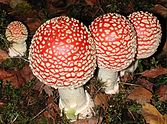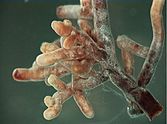A mycorrhiza (from Ancient Greek μύκης (múkēs) 'fungus' and ῥίζα (rhíza) 'root'; pl. mycorrhizae, mycorrhiza, or mycorrhizas)[1] is a symbiotic association between a fungus and a plant.[2] The term mycorrhiza refers to the role of the fungus in the plant's rhizosphere, the plant root system and its surroundings. Mycorrhizae play important roles in plant nutrition, soil biology, and soil chemistry.
In a mycorrhizal association, the fungus colonizes the host plant's root tissues, either intracellularly as in arbuscular mycorrhizal fungi, or extracellularly as in ectomycorrhizal fungi.[3] The association is normally mutualistic. In particular species, or in particular circumstances, mycorrhizae may have a parasitic association with host plants.[4]
- ^ Deacon, Jim. "The Microbial World: Mycorrhizas". bio.ed.ac.uk (archived). Archived from the original on 2018-04-27. Retrieved 11 January 2019.
- ^ Kirk, P. M.; Cannon, P. F.; David, J. C.; Stalpers, J. (2001). Ainsworth and Bisby's Dictionary of the Fungi (9th ed.). Wallingford, UK: CAB International.
- ^ Wu, Qiang-Sheng, ed. (2017). Arbuscular Mycorrhizas and Stress Tolerance of Plants (1st ed.). Springer Singapore. p. 1. doi:10.1007/978-981-10-4115-0. ISBN 978-981-10-4115-0.
- ^ Johnson, N. C.; Graham, J. H.; Smith, F. A. (1997). "Functioning of mycorrhizal associations along the mutualism–parasitism continuum". New Phytologist. 135 (4): 575–585. doi:10.1046/j.1469-8137.1997.00729.x. S2CID 42871574.



